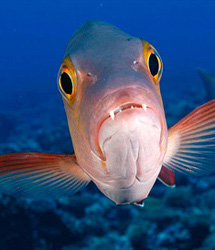
|
 |
 |
 Editorials | Environmental | February 2008 Editorials | Environmental | February 2008  
Coral Reefs and What Ruins Them
 Cornelia Dean - New York Times Cornelia Dean - New York Times
go to original


| | A red snapper shown here in a coral reef. Researchers who studied a string of Pacific Ocean atolls are painting the first detailed picture of pristine coral reefs and how they can be disrupted by people - particularly, they said, by fishing. (Zafer Kizilkaya) | | |
Researchers who studied a string of Pacific Ocean atolls are painting the first detailed picture of pristine coral reefs and how they can be disrupted by people - particularly, they said, by fishing.

The researchers, from the Scripps Institution of Oceanography and elsewhere in the United States and abroad, surveyed every form of life last summer in the northern Line Islands, a chain south of Hawaii. Their survey encompassed everything from microbes to sharks and other big fish at the top of the food chain.

"Reefs without people" were healthier than populated reefs, they say in a report to be posted Wednesday in the online Public Library of Science Biology. The ecosystems at Kingman and Palmyra, the northernmost and least populated atolls, are dominated by large predators like sharks and groupers, and corals there are robust, they said, while Tabuaeran and Kiritimati to the south, the most populated atolls, are characterized by fleshy algae, small plankton-eating fish and degraded corals.

In a commentary also published online, Nancy Knowlton and Jeremy B. C. Jackson, coral experts at Scripps and the Smithsonian Institution, said the new work was notable because it produced data at sites "across a full spectrum of human impacts." Without this kind of data, they write, studying coral reefs is like trying to discern the ecological structure of the Amazon rain forest by looking at the cattle ranches and soybean fields that have replaced much of it.

Actually, they write, it is even worse. Scientists can still visit vast areas of intact rain forest and have decades of data from earlier researchers. "The situation is very different for the oceans," Dr. Knowlton and Dr. Jackson wrote, because degradation of ocean ecosystems is so pervasive, and underwater observation is relatively recent. As a result, they said, scientists disagree over the relative importance for coral of local factors like overfishing and pollution as against global problems like climate change and the acidification of oceans it causes.

The Line Islands work will not settle those arguments. But the scientists noted great differences in the fish communities at inhabited and uninhabited reefs, which they attributed to fishing pressure on shark, grouper, snapper and other large predators, said Enric Sala, an ecologist formerly at Scripps and now at the National Council for Scientific Research in Spain.

Kingman is unpopulated - in fact, none of it is permanently above water. Palmyra was dredged extensively in the 1940s, the researchers said, and fishing has occurred there, but today both atolls are protected by the United States Fish and Wildlife Service as part of the Pacific/Remote Islands National Wildlife Refuge. A camp at Palmyra, with a capacity of 20, has its own sewage treatment center.

Tabuaeran, with a growing population estimated in 2005 at 2,500, and Kiritimati, with 5,100 people and growing even faster, are part of the Republic of Kiribati. People there subsist on fishing and have no sewage treatment facilities.

At Kingman and Palmyra, the ocean ecosystem is dominated by large top-predator fish, species "virtually absent" at Tabuaeran and Kiritimati, also known as Christmas Island. The researchers said this was the typical pattern elsewhere in the world, except the northwestern Hawaiian Islands.

They attributed it to fishing pressure which, they said, "tends to disproportionately reduce densities of longer-lived, larger-bodied individuals."

The pattern in the uninhabited atolls, though, "is similar to what we see in Yellowstone - the landscape of fear," Dr. Sala said. "In Yellowstone there are all these wolves, and the deer are much more attentive."

As a result, he said, small fish spend much of their time hiding. "When people see photos they say, 'Well, the water is empty,' " he said. "For me, it's prettier because the corals are healthy and clean and you don't see seaweed in the reefs and you see these big snappers and sharks." There are far more fish on degraded reefs, he said, but they are far smaller. "The percentage of the bottom cover by large corals declines, the seaweed takes over, then the microbes become much more abundant," he said.

The researchers said coral cover, density and species richness were highest at Kingman and lowest at Kiritimati. Coral disease was most prevalent at Kiritimati, they said.

Dr. Sala acknowledged that by the standards of the Caribbean and other heavily exploited areas, Tabuaeran and Kiritimati are in pretty good shape. But, he added, "there are 5,000 people living in Christmas and fishing there," enough "to transform the whole ecosystem."

At the moment, the assessment leaves the researchers with questions as well as answers. For example, reefs like Tabuaeran and Kiritimati don't seem to survive as well in episodes of disease or bleaching. Is it because of fishing? To find out, the researchers wrote, they will have to measure how coral growth and fish productivity respond to fishing pressure and how they all interact with episodes of warm water.

But for Dr. Sala, the reefs are like "ecological machines" whose parts include plants, fish, corals and microbes. "You can hit the system with a disturbance, but the system comes back," he said. But if pieces - like big predatory fish - are removed, he said, "the machine is going to malfunction."

As a result, he said, the new work "is an argument for marine reserves large enough to include healthy populations of top predators." | 
 | |
 |



